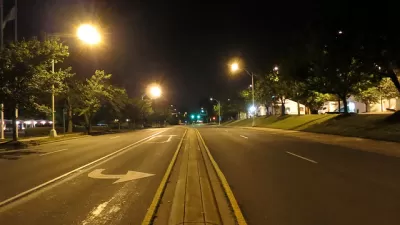Little Asphalt minimizes pavement in cities, towns, and suburbs so that real estate can be used for higher value purposes—such as buildings and people-centered activities.
I have written about the problems of Big Asphalt. The opposite is Little Asphalt, which can be described in three ways.
1) It’s an approach that minimizes pavement in cities, towns, and suburbs so that real estate can be used for higher value purposes—such as buildings and people-centered activities. Little asphalt disperses traffic rather than concentrates it. It eases automotive traffic through expanding opportunities for walking, bicycling, transit, and other ways to get around. It reduces impervious surfaces that create stormwater runoff.
2) It’s a place dominated by the character of the surroundings and activities rather than the pavement. Little Asphalt is a magnet for people, not cars. Automobiles are usually welcome—but only at speeds that do not threaten the safety of the people or the character of the place.
3) Little Asphalt represents the interests that benefit from such places—In this case, the communities themselves, the people who live and use these communities, and the landowners who will benefit from higher values created by Little Asphalt.
Little Asphalt recognizes that pavement itself is a big part of sprawl—not just houses spread out across the landscape, a car-oriented lifestyle, big box stores, and disinvestment in cities. Vast parts of America are over-paved in a relentless—and often futile—pursuit of frictionless driving. Highways slice through cities and downtown buildings are leveled in favor of parking lots. Most of the suburbs are not walkable because of excess paving since the middle of the 20th Century. Little Asphalt runs this process in reverse and is essential for creating more walkable, people-centered places.
FULL STORY: The Little Asphalt solution for sustainable, healthy communities

Alabama: Trump Terminates Settlements for Black Communities Harmed By Raw Sewage
Trump deemed the landmark civil rights agreement “illegal DEI and environmental justice policy.”

Study: Maui’s Plan to Convert Vacation Rentals to Long-Term Housing Could Cause Nearly $1 Billion Economic Loss
The plan would reduce visitor accommodation by 25% resulting in 1,900 jobs lost.

Planetizen Federal Action Tracker
A weekly monitor of how Trump’s orders and actions are impacting planners and planning in America.

Restoring Northern India’s Himalayan ‘Water Temples’
Thousands of centuries-old buildings protect the region’s natural springs and serve as community wells and gathering places.

Milwaukee to Double Bike Share Stations
Bublr Bikes, one of the nation’s most successful, will add 500 new e-bikes to its system.

DC Extends Application Window for Outdoor Dining Permits
District restaurants will have until the end of November to apply, but businesses with permits in rush hour parking lanes must end operations on July 31.
Urban Design for Planners 1: Software Tools
This six-course series explores essential urban design concepts using open source software and equips planners with the tools they need to participate fully in the urban design process.
Planning for Universal Design
Learn the tools for implementing Universal Design in planning regulations.
Caltrans
Smith Gee Studio
Institute for Housing and Urban Development Studies (IHS)
City of Grandview
Harvard GSD Executive Education
Toledo-Lucas County Plan Commissions
Salt Lake City
NYU Wagner Graduate School of Public Service



























